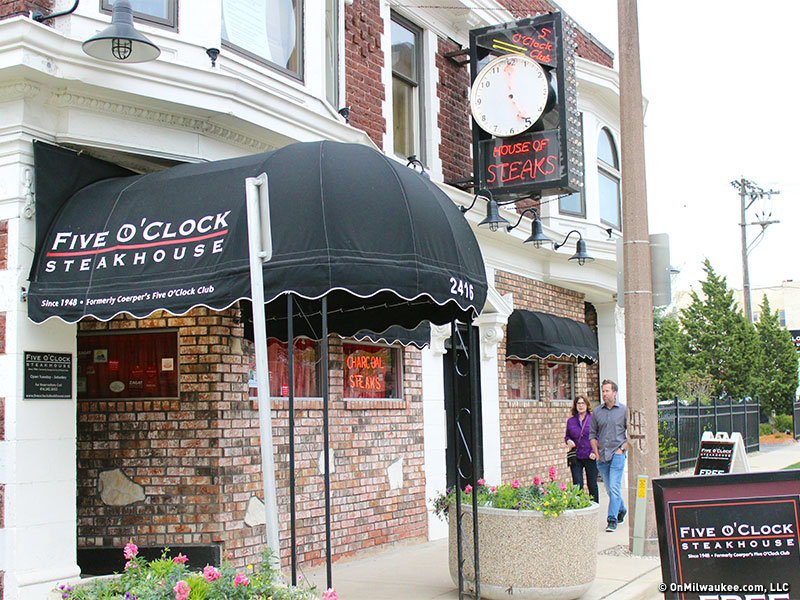Steak -- in various forms -- has been a staple of the human diet since the first caveman knocked out his first woolly mammoth.
A versatile dish, it can be the centerpiece of a fancy night on the town or a great way to spend a summer evening with friends and family.
At The Capital Grille, 310 W. Wisconsin Ave., steaks are the main attraction.
The restaurant offers a wide selection of certified Angus cuts, grilled to perfection -- and to order -- under the supervision of Executive Chef Jeff Beale. All the beef comes from Midwestern producers and Beale also incorporates local producers into the menu.
The secret to The Capital Grille's menu, Beale says, is the restaurants dry-aging process. All cuts are "wet-aged" for two weeks and then are "dry-aged" for another 14 days.
Dry-aging involves hanging the beef side in a cooler, allowing moisture to evaporate from the muscle. The natural enzymes in the meat break down the muscle tissue further, leading to much more tender cuts.
"It gives the steak a more tender and unique flavor than if you cut it and grilled it," Beale says.
Servers and kitchen staff are well-trained in the different cuts and preparation methods of various steaks. The most popular order, according to Managing Partner Paul Hawkins, is the filet; a juicy and tender cut that comes from the tenderloin; a non-weight-bearing portion of a steer, meaning it is not hardened muscle.
Choosing the appropriate cut is an important part of a great steak dinner. Aside from filets, a ribeye cut has significant marbling, meaning a more flavorful cut of meat. Porterhouses and T-bone steaks are thicker and are on the higher-end of the price spectrum.
Neither the aging process nor the cut matters if a steak isn't properly cooked. At The Capital Grille, Beale's staff uses a high-heat broiler to create a perfect sear, cooking the outside enough to trap the juices and flavors from the dissolved marbling inside.
The servers are well-trained in the different preparation options available and have learned -- through a tasting process -- to make educated suggestions to guests depending on the cut they order.
"They don't have to like it," says Hawkins. "But we want them to know what it tastes like so they can explain that and make recommendations to our guests so they have an idea of what will be presented in front of them."
Medium is the most popular way to order a steak at The Capital Grille. But Beale is quick to point out that certain cuts are better served when cooked longer, despite personal preferences.
"We recommend a filet to be served mid-rare," Beale says. "When we serve a Delmonico, we recommend it medium or above to break down the marbling and get the full flavor."
Fine dining isn't always an affordable option. Luckily, though, replicating the taste of an upscale steakhouse at home isn't difficult. It is possible to get your hands on the same high-quality cuts served at the finest restaurants.
Beale's No. 1 suggestion? Get to know your butcher.
"You want to get to know the person who is selling you that food," Beale says. "It's important to develop a relationship with that person. You should be able to ask where the meat came from, when it came in and when it was cut. Those are questions they should be able to answer for you."
At the Pick 'n Save Metro Market, 1123 N. Van Buren St., Meat Manager Bob Milbrandt answers those questions, helping customers select a cut of meat that fits their taste.
He's spent many years in the industry, working in various capacities. He joined Metro Market when it opened, and has since seen his diet include more and more beef. He chalks it up to the steakhouse-quality of Metro Market's offerings.
"I have a hard time sometimes when I leave," Milbrandt says. "I'll see something in the case and want to take it home. In 25 years of working in the meat business, I haven't eaten as much red meat as I have since I've been here because everything that comes out is just gorgeous.
Metro Market offers three different grade of Angus beef; prime, choice and a newer line of 100 percent natural beef. Prime cuts will have 20 to 30 percent marbling and are the highest-quality.
Milbrandt suggests filets for the novice griller, but personally prefers the flavor of a ribeye.
"It has the best flavor, in my opinion," Milbrandt says, "It's not necessarily the most tender, but it does have the most flavor."
With the cut in hand, it's important to get a good, hot fire going. Beale suggests a charcoal grill, mainly for the ability to generate heat, but also because of the flavor generated from the flames.
Leaner cuts are better served rarer, while cuts with more marbling need slightly longer cooking times to get the juices going.
"If just throw a steak on a cold grill, it's like putting the meat in a warm oven," Beale says. "You don't get that sear, it just kind of slow-cooks and gives you more of a roast flavor, rather than a steak that's juicy and has its flavor intact."
When the steak is done, letting the meat rest is important. At The Capital Grille, the steaks are taken off the fire for about five minutes after cooking to let the meat settle and the juices spread. Prior to serving, the meat is placed briefly back onto the fire to give it a warm-up.
And of course, if your steak doesn't turn out the way you want it to at home, Beale would be happy to grill one up for you.







